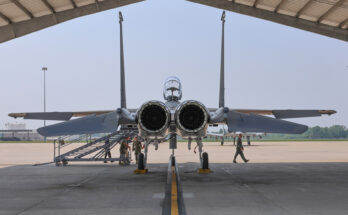
Over $9 billion will be spent into the next decade on the Joint All-Domain Command and Control (JADC2) program, a sweeping R&D effort of the U.S. Air Force, Army, and Navy. While there are many programs that support JADC2 in one way or another, the three biggest drivers are the Air Force’s Advanced Battle Management System (ABMS), the Army’s Project Convergence, and the Navy’s Project Overmatch.
JADC2 is the U.S. Department of Defense’s concept to connect sensors from all of the military services into a single network. The concept involves linking existing and future sensors, shooters, and platforms across the land, air, sea, space, and cyber domains. In this effort, any given platform serves as an intelligence and communications node, allowing warfighters to stay connected and to always have the latest battlefield information.
Every year since 2020, the U.S. Air Force, as overall program leader, has been awarding contracts from an initial $950 million order to multiple U.S. companies – from technology research groups and manufacturers to management and consulting firms – for work related to advancing JADC2 and ABMS.
In June 2022, the Air Force selected five companies to join the ABMS Digital Infrastructure Consortium: L3Harris, Northrop Grumman, Leidos, RTX (formerly Raytheon), and SAIC.
According to U.S. Army budget documents, Project Convergence will enable lethal and non-lethal effects across all domains using AI and machine learning to improve threat recognition, augment and enhance leader decision-making, and replicate tactical behaviors to enable autonomous capabilities. Work under the program complements the Army’s Future Vertical Lift Advanced Technology and Next Generation Combat Vehicle Advanced Technology efforts.
The Army began its first Project Convergence exercises in 2020. Given that the Army refers to Project Convergence as a “campaign of learning,” designed to further integrate the Army into the Joint Force, these exercises constitute the heart of the program.
In a major restructuring move related to Convergence activity, RTX, in June 2023, shifted control of a significant part of its JADC2 business to Collins Aerospace, with its long history of advancing development of secure network technology.
Around the same time, Collins demonstrated a networking gateway at the U.S. Indo-Pacific training exercise Northern Edge. The gateway utilized autonomous routing technologies that bridged disparate line-of-sight (DLOS) and beyond line-of-sight (BLOS) networks across multiple security levels.
One of the two driving forces behind JADC2 is the desire to incorporate the latest technological advancements into existing and developing systems and networks such as 5G, cloud computing, AI, and machine learning. The second major driver is the constantly evolving worldwide threat environment where electronic warfare in general and cyberwarfare in particular have steadily become adversarial tools.
The not-surprising news that Russia and China are advancing connectivity efforts along similar lines to JADC2 and are looking at ways of disrupting and defeating the U.S. effort has also added impetus to the program.
The JADC2 program is now covered in a newly published report, found in Forecast International’s C4I Forecast. C4I Forecast provides the critical data needed to navigate this expansive market. This volume provides long-range funding and development outlooks for the radios, communication networks, cyber defense systems, datalinks, and sensor systems that equip today’s armed forces, or are currently in development.
Andrew Dardine is lead analyst for Forecast International's Defense Electronic Systems group. He is the primary author of Forecast International's Electronic Warfare Forecast and co-author of Electro-Optical Systems Forecast and C4I Forecast. Andrew is also a regular contributor to FI's Defense & Security Monitor blog, offering insights into developing technologies such as directed-energy and next-generation jamming systems. His analysis of such vital market areas as EO/IR systems and electronic countermeasures technology has been cited in Defense News, Aerospace Daily, and Bloomberg Businessweek, among other news media. He has also written about the electronic defense market for Aviation Week and the Journal of Electronic Defense.




